239. There is a curious
expression in the Swedish language: 'bjuda
med armbågen' ('to offer with the
elbow'), i.e. to invite someone in a way
which shows a deliberate and cold intention
of not giving anything at all away -.the
opposite of stretching out (as in Mebsuta,
ε Gemini) an inviting and
giving hand (or paw).
At the time when a young one is sucking he
will, if possible, not allow anyone else to
take part, this we can observe everywhere
among us living creatures.
During his intake (sucking) - from the sweet
water pools on the 'upraised reef' - the Sun would have his hand
towards his mouth, showing only his hard
elbow in front (as in
ζ Gemini, Mekbuda):
 |
 |
 |
 |
|
Aa1-17 |
Aa1-18 |
Aa1-19 |
Aa1-20 |
 |
 |
 |
 |
|
Aa1-21 |
Aa1-22 |
Aa1-23 |
Aa1-24 |

3 golden rings = 3 * 26 = 78 (March 19)
The fundamental distinction between a
benevolent and giving hand open in front,
empty after having giving it all away,
... The practice of turning
down the fingers, contrary to our practice,
deserves notice, as perhaps explaining why
sometimes savages are reported to be unable
to count above four. The European holds up
one finger, which he counts, the native
counts those that are down and says 'four'.
Two fingers held up, the native counting
those that are down, calls 'three'; and so
on until the white man, holding up five
fingers, gives the native none turned down
to count. The native is nunplussed, and the
enquirer reports that savages can not count
above four ...
and a hand used for 'sucking' (primitive man
is drinking not from a glass of water but
from a spring using his cupped hand and
throwing its contents into the mouth)
corresponds to the distinction between
returning (spitting out)
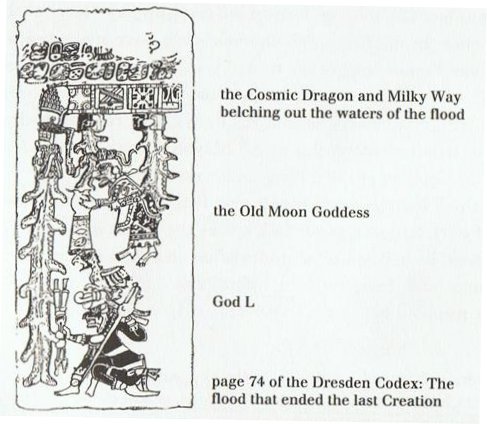
 |
|
Aa6-66 (482, 1146) |
|
e he goe
kua moe |
|
Goe.
Milky Way. Vanaga. |
 |
 |
 |
|
Cb14-17 (346) |
Cb14-18 |
Cb14-19 (740) |
|
kokoti hia
te henua |
tagata hakaitiiti |
i te henua |
|
α Muscae (190.2),
τ Centauri (190.5), χ
Virginis (190.7)
ALDERAMIN (α
Cephei) |
Al Áwwā'-11 (The Barker)
/
Shur-mahrū-shirū-18
(Front or West Shur)
SOMBRERO GALAXY = M104
Virginis
(191.1), ρ Virginis (191.4),
PORRIMA = γ
Virginis,
γ Centauri (191.5) |
ι Crucis (192.2), β Muscae
(192.5),
MIMOSA
= β Crucis
(192.9) |
 |
|
Sept 27 (270) |
28 |
29 (*192) |
|
19 July (200) |
20 |
21 (*122) |
|
ANDROMEDA GALAXY (M31),
π Andromedae (7.7) |
ε Andromedae (8.2),
DELTA = δ Andromedae (8.4),
SCHEDIR (Breast)
= α Cassiopeiae
(8.6), ζ Andromedae, μ
Phoenicis (8.9) |
ξ Phoenicis (9.0), ρ Tucanae
(9.1),
DENEB KAITOS (Tail of the
Sea Beast) = β Ceti,
η Phoenicis (9.4),
AL NITHĀM (String of Pearls)
= φ¹ Ceti
(9.6) |
|
... Traditionally, remark,
the kava root was
chewed to make the infusion:
The sacrificed child of the
people is cannibalized by
the young chiefs. The water
of the kava, however,
has a different symbolic
provenance. The classic
Cakaudrove kava
chant, performed at the
Lau installation rites,
refers to it as sacred rain
water from the
heavens... This male and
chiefly water (semen) in the
womb of a kava bowl
whose feet are called
'breasts' (sucu), and
from the front of which,
tied to the upper part of an
inverted triangle, a sacred
cord stretches out toward
the chief ...
The cord is decorated with
small white cowries, not
only a sign of chieftainship
but by name, buli leka,
a continuation of the
metaphor of birth - buli,
'to form', refers in Fijian
procreation theory to the
conceptual acception of the
male in the body of the
woman. The sacrificed child
of the people will thus give
birth to the chief. But only
after the chief, ferocious
outside cannibal who
consumes the cannibalized
victim, has himself been
sacrificed by it. For when
the ruler drinks the sacred
offering, he is in the state
of intoxication Fijians call
'dead from' (mateni)
or 'dead from kava' (mate
ni yaqona), to recover
from which is explicitly 'to
live' (bula). This
accounts for the second cup
the chief is alone accorded,
the cup of fresh water. The
god is immediately revived,
brought again to life - in a
transformed state ... |
|
March 28 (*7) |
29 (88) |
30 |
|
17 Jan (270 - 183) |
18 (365 + 18 = 383) |
19 (13 * 29½ - ½) |
and drawing back (sucking). The cycle has to
go on, has to be completed (haka-taka,
Fakataka), or time will stop.
... He was moreover confronted with
identifications which no European, that is,
no average rational European, could admit.
He felt himself humiliated, though not
disagreeably so, at finding that his
informant regarded fire and water as
complementary, and not as opposites. The
rays of light and heat draw the water up,
and also cause it to descend again in the
form of rain. That is all to the good. The
movement created by this coming and going is
a good thing. By means of the rays the Nummo
draws out, and gives back the life-force.
This movement indeed makes life.
The old man realized that he was now at a
critical point. If the Nazarene did not
understand this business of coming and
going, he would not understand anything
else. He wanted to say that what made life
was not so much force as the movement of
forces. He reverted to the idea of a
universal shuttle service. 'The rays drink
up the little waters of the earth, the
shallow pools, making them rise, and then
descend again in rain.' Then, leaving aside
the question of water, he summed up his
argument: 'To draw up and then return what
one had drawn - that is the life of the
world' ...
|
Taka,
takataka. Circle; to form
circles, to gather, to get together
(of people). Vanaga.
1. A dredge. P Mgv.:
akataka, to fish all day
or all night with the line, to throw
the fishing line here and there.
This can only apply to some sort of
net used in fishing. We find in
Samoa
ta'ā a small fishing line,
Tonga taka the short line
attached to fish hooks, Futuna
taka-taka a fishing party of
women in the reef pools (net), Maori
takā the thread by which the
fishhook is fastened to the line,
Hawaii kaa in the same sense,
Marquesas takako a badly spun
thread, Mangareva takara a
thread for fastening the bait on the
hook. 2. Ruddy. 3. Wheel, arch;
takataka, ball, spherical,
round, circle, oval, to roll in a
circle, wheel, circular piece of
wood, around; miro takataka,
bush; haga takataka, to
disjoin; hakatakataka, to
round, to concentrate. P Pau.:
fakatakataka, to whirl around.
Mq.: taka, to gird. Ta.:
taa, circular piece which
connects the frame of a house.
Churchill.
Takai, a curl, to tie;
takaikai, to lace up;
takaitakai, to coil. P Pau.:
takai, a ball, to tie. Mgv.:
takai, a circle, ring, hoop, to
go around a thing. Mq.: takai,
to voyage around. Ta.: taai,
to make into a ball, to attach.
Churchill. |
In day 150 (May 30, 80 + 70 = 300 / 2) the Janus type
of division illustrated in Ga1-6 has
benevolent light in front but a dark figure
with an egoistically sucking elbow shown at
the back side, giving no light at all away:
In the C text nakshatra Polaris at the last glyph on
side a was illustrated by a giving (and empty) type of hand and the measure counted
from Ca13-20 (→ 260) to the position of
Polaris amounted to 29 (as in Mercury alias Nabū
alias
Hiro) days, which added to those 348
glyphs on side b will become 377 (= 13 *
29).
...
Whiro
'Steals-off-and-hides'; also [in addition to
the name of Mercury] the universal name for
the 'dark of the Moon' or the first day of
the lunar month; also the deity of sneak
thieves and rascals ...
260 + 29 = 289, which can be understood as
289 + 'day zero' (when at the time of
rongorongo the Full Moon was at the Navel of
the Horse, Sirrah, α Andromedae, i.e. when
the Sun had reached the Raven at Alchita, α
Corvi); and 290 = 10 * 29. Consequently 377
will then change to day zero + 377 = 378
(300 + 3 * 26).
... The ordinary year in the
previous Roman calendar consisted of 12
months, for a total of 355 days. In
addition, a 27-day intercalary month, the
Mensis Intercalaris, was sometimes
inserted between February and March. This
intercalary month was formed by inserting 22
days after the first 23 or 24 days of
February; the last five days of February,
which counted down toward the start of
March, became the last five days of
Intercalaris. The net effect was to add 22
or 23 days to the year, forming an
intercalary year of 377 or 378 days ...
 |
 |
 |
 |
 |
28 |
 |
|
Ca13-16 |
Ca13-17 (360) |
Ca13-18 |
Ca13-19 |
Ca13-20 (354 + 9) |
*Ca14-29 (392) |
|
oho te vae |
tagata puoko erua |
tagata puo pouo |
te vero hia |
- |
te rima |
|
3-14 (→ π) |
March 15 |
16 |
17 |
18 (77) |
April 16 (106) |
|
'Febr 15 |
16 |
17 |
18 |
19 (50) |
'March 20 (79) |
|
"Febr 1 |
2 |
3 |
4 |
5 (36) |
"March 6 (65) |
|
350 |
351 |
352 |
353 |
12 * 29½ |
383 |
...
Ganz ähnlich is der Name
'Gott von Duazag' des
Gottes Nabū ... zu
erklären.
Er bezeichnet ihn als den
Gott des Wachtstums, welches
als aus dem Osten stammend
betrachtet wird, weil die
Sonne, die das Wachstum
bringt, im Osten aufgeht.
Dass aber Nabū als
Ost-Gott aufgefasst wurde,
hängt damit zusammen, dass
sein Stern, der Mercur, nur
im Osten oder Westen
sichtbar ist
...
... February
29 [2-29] is the 60th day of
the Gregorian calendar in a
leap-year, with 306 days
remaining until the end of
the year ...
... Menkaure was
allegedly a much more
benevolent Pharaoh than his
predecessors. According to
legends related by
Herodotus, he wrote the
following:
This Prince (Mycerinus)
disapproved of the conduct
of his father, reopened the
temples and allowed the
people, who were ground down
to the lowest point of
misery, to return to their
occupations and to resume
the practice of sacrifice.
His justice in the decision
of causes was beyond that of
all the former kings. The
Egyptians praise him in this
respect more highly than any
other monarchs, declaring
that he not only gave his
judgements with fairness,
but also, when anyone was
dissatisfied with his
sentence, made compensation
to him out of his own purse
and thus pacified his anger.
The Gods however ordained
that Egypt should suffer
tyrannical rulers for a
hundred and fifty years
according to this legend.
Herodotus goes on:
... An oracle reached him
from the town of Buto,
which said 'six years only
shalt thou live upon this
earth, and in the seventh
thou shalt end thy days'.
Mycerinus, indignant,
sent an angry message to the
oracle, reproaching the god
with his injustice - 'My
father and uncle,' he said
'though they shut up the
temples, took no thought of
the gods and destroyed
multitudes of men,
nevertheless enjoyed a long
life; I, who am pious, am to
die soon!' There came in
reply a second message from
the oracle - 'for this very
reason is thy life brought
so quickly to a close - thou
hast not done as it behoved
thee. Egypt was fated to
suffer affliction one
hundred and fifty years -
the two kings who preceded
thee upon the throne
understood this - thou hast
not understood it'.
Mycerinus, when this
answer reached him,
perceiving that his doom was
fixed, had lamps prepared,
which he lighted every day
at eventime, and feasted and
enjoyed himself unceasingly
both day and night, moving
about in the marsh-country
and the woods, and visiting
all the places he heard were
agreeable sojourns. His wish
was to prove the oracle
false, by turning night into
days and so living twelve
years in the space of six
...
.jpg)
July (31) + August (31), the
new months added by Julius Caesar, = 62 = 70
- 8, and 300 (Khufu + Khafre) + 2 * 6
(Menkaure) = 372 = 6 * 62.
On side a on the G tablet (carrying 229
glyphs) we can see how the season of toga,
with giving (= returning) hands, ended at
*118.4 (Φ Gemini) or precisely 107 days
after η Andromedae (*11.4), which rose
heliacally in April 1 (91):

|
|
toga |
|
Toga. 1.
Winter season. Two seasons used to
be distinguished in ancient times:
hora, summer, and toga,
winter. 2. To lean against somehing;
to hold something fast; support,
post supporting the roof. 3. To
throw something with a sudden
movement. 4. To feed oneself, to eat
enough; e-toga koe ana oho ki te
aga, eat well first when you go
to work. Vanaga. 1. Winter. P Pau.,
Mgv.: toga, south. Mq.:
tuatoka, east wind. Ta.: toa,
south. 2. Column, prop; togatoga,
prop, stay. Togariki,
northeast wind. Churchill.
Wooden platform for a dead chief:
ka tuu i te toga (Bb8-42), when
the wooden platform has been
erected. Barthel 2. The expressions
Tonga, Kona, Toa
(Sam., Haw., Tah.), to indicate the
quarter of an island or of the wind,
between the south and west, and
Tokelau, Toerau,
Koolau (Sam., Haw., Tah.), to
indicate the opposite directions
from north to east - expressions
universal throughout Polynesia, and
but little modified by subsequent
local circumstances - point strongly
to a former habitat in lands where
the regular monsoons prevailed.
Etymologically 'Tonga', 'Kona',
contracted from 'To-anga' or
'Ko-ana', signifies 'the
setting', seil. of the sun. 'Toke-lau',
of which the other forms are merely
dialectical variations, signifies
'the cold, chilly sea'. Fornander. |
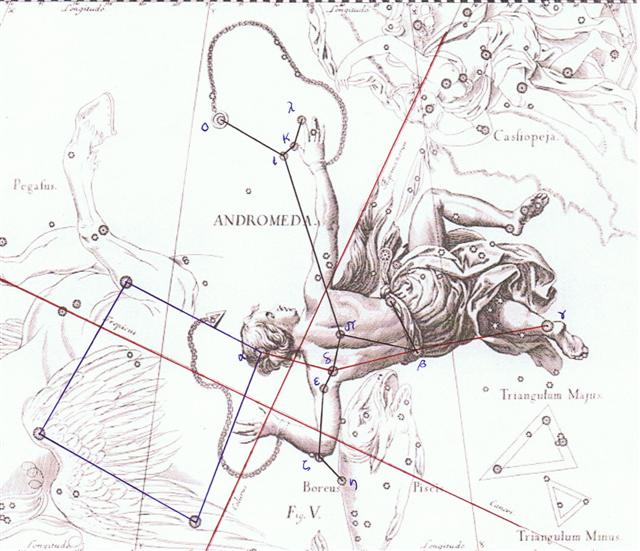
| |
|
Delta |
δ
Andromedae |
8.4 |
March 29 (88) |
| |
|
|
η
Phoenicis |
9.4 |
March 30 (89) |
|
0 |
- |
Zero |
η Andromedae |
11.4 |
April 1 (91) |
| |
|
Whip |
Cih (γ Cassiopeiai) |
12.4 |
April 2 (92) |
|
1 |
Al Sharatain |
Pair of Signs |
β Arietis (Sheratan),
γ (Mesarthim) |
27.4 |
April 17 (107) |
| |
|
Musca Borealis |
35 (Head of the Fly), 39
(Kaffaljidhma), and
41 Arietis (Bharani) |
41.4 |
May 1 (121) |
|
2 |
Al Dabarān |
Follower |
α Tauri (Aldebaran), θ¹, θ²´,
γ (Hyadum I),
δ (Hyadum II), ε (Ain) |
63.4 |
May 23 (143) |
| |
|
|
Mintaka (δ Orionis) |
82.4 |
June 11 (162) |
|
3 |
Al Hak'ah |
White Spot |
λ Orionis (Heka),
φ¹, φ² |
83.4 |
June 12 (163) |
|
4 |
Al Han'ah |
Brand |
γ Gemini (Alhena), μ (Tejat
Posterior), ν,
η (Tejat Prior),
ξ (Alzirr) |
93.4 |
June 22 (173) |
|
5 |
Al Dhirā' |
Forearm |
α Gemini (Castor),
β (Pollux) |
113.4 |
July 12 (193) |
| |
|
Unicorn |
α Monocerotis |
115.4 |
July 14 (195) |
| |
|
|
Φ Gemini |
118.4 |
July 17 (198) |
The Forearm (Al Dhirā')
was hardly a description referring to the
extremities of our Gemini twins, because
their stars (Castor and Pollux) were at
their heads:

Instead it may have referred
to the end of the ancient season of 'sucking',
because a forearm was the common tool used
as a measure of length, and the pair
Mebsuta
(Outstretched) and Mekbuda
(Contracted) were together giving 5 days as
their measure. 185 (July 4) - June 29 (190)
= 5.
Furthermore, 193 (July 12 at
heliacal Castor) - 78 (March 19) = 115
(April 25):
... Later on in this series of rituals, the
Chorti go through a ceremony they
call raising the sky. This ritual takes
place at midnight on the twenty-fifth of
April and continues each night until the
rains arrive. In this ceremony two diviners
and their wives sit on benches so that they
occupy the corner positions of the cosmic
square. They take their seats in the same
order as the stones were placed, with the
men on the eastern side and the women on the
west. The ritual actions of sitting down and
lifting upward are done with great precision
and care, because they are directly related
to the actions done by the gods at Creation.
The people represent the gods of the four
corners and the clouds that cover the
earth.
As they rise from their seats, they
metaphorically lift the sky. If their
lifting motion is uneven, the rains will be
irregular and harmful
...
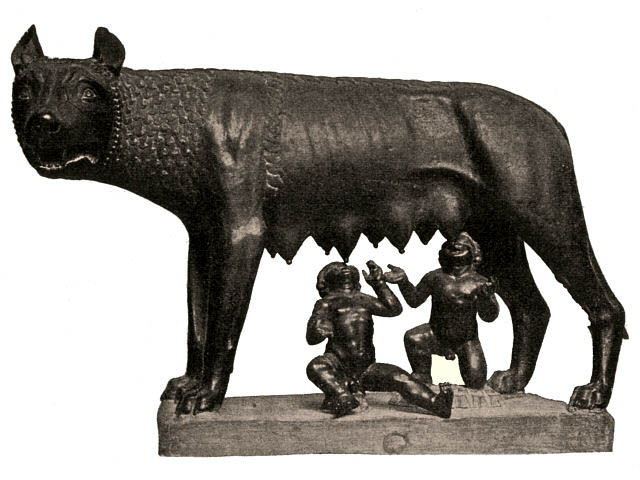
According to Allen the names
Mebsuta
and Mekbuda were describing the pair
of front legs of the ancient greater Leo.
Although the Chinese had the contracted
front paw of their Tiger earlier than his
outstretched front leg:
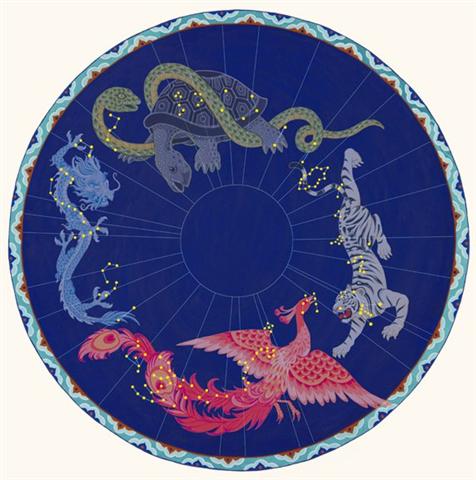
|
APRIL 17 (107) |
18 |
19 |
20 (*30) |
21 |
|
11 April |
12 |
13 |
14 (104 = 78 + 26) |
15 (*25) |
 |
 |
 |
 |
 |
|
Ga1-27 |
Ga1-28 |
Ga1-29 |
Ga1-30 |
Ga2-1 |
|
6h (91.3)
ν Orionis (91.4), θ Columbae
(91.5), π Columbae (91.6) |
ξ Orionis (92.5) |
Al Han'ah-4 (Brand) /
Maru-sha-pu-u-mash-mashu-7
(Front of the Mouth of the
Twins)
TEJAT PRIOR = η Gemini
(93.4), γ Monocerotis
(93.5), κ Aurigae (93.6), κ
Columbae (93.8) |
FURUD
= ζ Canis Majoris
(94.9) |
Well-22 (Tapir) /
Arkū-sha-pu-u-mash-mashu-8
(Back of the Mouth of
the Twins)
δ Columbae (95.2),
TEJAT POSTERIOR = μ Gemini,
MIRZAM = β Canis Majoris
(95.4),
CANOPUS
= α Carinae
(95.6), ε Monocerotis
(95.7), ψ1 Aurigae (95.9) |
|
June 20 |
SOLSTICE |
22 (*93) |
23 (174) |
ST JOHN'S DAY |
|
°June 16 |
17 (168) |
18 |
19 |
20 (*91) |
|
'May 24 (144) |
25 |
26 |
27 |
28 (*68) |
|
"May 10 (130) |
11 |
12 |
13 |
14 (*54) |
 |
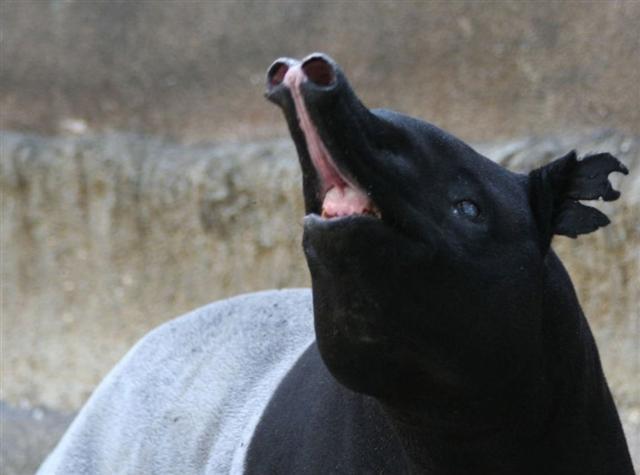
... The Pythagoreans make
Phaeton fall into
Eridanus, burning part of
its water, and glowing still
at the time when the
Argonauts passed by. Ovid
stated that since the fall
the Nile hides its sources.
Rigveda 9.73.3 says that the
Great Varuna has hidden the
ocean. The Mahabharata tells
in its own style why the
'heavenly Ganga' had to be
brought down. At the end of
the Golden Age (Krita
Yuga) a class of
Asura who had fought
against the 'gods' hid
themselves in the ocean
where the gods could not
reach them, and planned to
overthrow the government. So
the gods implored Agastya
(Canopus, alpha Carinae =
Eridu) for help. The great
Rishi did as he
was bidden, drank up the
water of the ocean, and thus
laid bare the enemies, who
were then slain by the gods.
But now, there was no ocean
anymore! Implored by the
gods to fill the sea again,
the Holy One replied: 'That
water in sooth hath been
digested by me. Some other
expedient, therefore, must
be thought of by you, if ye
desire to make endeavour to
fill the ocean ...
 |
|
APRIL 22 |
23 |
24 |
25 (*35) |
26 |
27 |
28 (118) |
|
16 April |
17 |
18 |
19 (*29) |
20 |
21 (111) |
22 |
 |
 |
 |
 |
 |
 |
 |
|
Ga2-2 |
Ga2-3 |
Ga2-4 |
Ga2-5 (35) |
Ga2-6 |
Ga2-7 |
Ga2-8 |
|
no star listed (96) |
β Monocerotis, ν Gemini (97.0) |
no star listed (98) |
ν Puppis (99.2), ψ3 Aurigae
(99.4), ψ2 Aurigae (99.5)
GEMMA (α Cor. Bor.)
|
ψ4 Aurigae (100.5),
MEBSUTA (Outstretched)
= ε Gemini
(100.7) |
SIRIUS = α Canis Majoris
(101.2), ψ5 Aurigae (101.4), ν
Gemini (101.6), ψ6 Aurigae
(101.7) |
τ Puppis (102.2), ψ7 Aurigae
(102.4) |
|
June 25 |
26 |
27 |
28 |
29 (180) |
30 |
July 1 |
|
SOLSTICE |
°June 22 |
23 |
ST JOHN'S DAY |
25 (*96) |
26 (177) |
27 |
|
'May 29 |
30 (150) |
31 |
'June 1 |
2 |
3 |
4
(*75) |
|
"May 15 (500) |
16 (136) |
17 |
18 |
19 |
20 |
21 (*61) |
|
"When the Arabians adopted the
Greek figures they designated
this star [Castor] as Al Rās
al Taum al Mukaddim, the
Head of the Foremost Twin; but,
according to Al Tizini, the
early and indigenous term was
Al Awwal al Al Dhirā',
the First in the Paw or Forearm.
Reference was made by this to
the supposed figure of the
enormous early Lion, the nomads'
Asad, the Outstretched
Forearm of which
α
and β marked
Al Dhirā' al Mabsutāt.
This extended still further over
Gemini, the other, the
Contracted one, Al Dhirā' al
Makbūdah, running into Canis
Minor. The rest of this
monstrosity included Cancer,
part of our Leo, Boötes, Virgo,
and Corvus ..." (Allen) |
|
APRIL 29 |
30 |
MAY 1 (*41) |
2 (122) |
|
23 April |
24 |
25 (115 = 105 + 10) |
26 (*36) |
 |
 |
 |
 |
|
Ga2-9 |
Ga2-10 |
Ga2-11 |
Ga2-12 (42) |
|
Mash-mashu-sha-Risū-9
(Twins of the Shepherd)
θ Gemini (103.0), ψ8 Aurigae
(103.2),
ALHENA = γ Gemini
(103.8), ψ9 Aurigae (103.9) |
ADARA (Virgins) = ε Canis
Majoris
(104.8) |
ω Gemini (105.4),
ALZIRR (Button) = ξ Gemini
(105.7),
MULIPHEIN (Oaths) = γ Canis
Majoris
(105.8),
MEKBUDA (Contracted)
= ζ Gemini
(105.9) |
7h (106.5)
no star listed (106) |
|
July 2 |
(*104 = 8 * 13) |
4 (185) |
5 |
|
ºJune 28 |
29 (*100) |
SIRIUS |
ºJuly 1 (182) |
|
'June 5 |
6 (157) |
7 (*78) |
8 |
|
"May 22 |
23 |
24 (144) |
25 (*65) |
|
... Al Maisān, the
title of
γ
Geminorum [Alhena], by some
error of Firuzabadi was
applied to this star [Heka
in Orion] as Meissa,
and is now common for it. Al
Sufi called it Al Tahāyī;
but Al Ferghani and Al
Tizini knew it as Rās al
Jauzah, the Head of the
Jauzah, which it marks. The
original Arabic name, Al
Hak'ah, a White Spot,
was from the added faint
light of the smaller
φ¹and
φ²
in the background, and has
descended to us as Heka
and Hika. These three
stars were another of the
Athāfiyy [tripods used
for cooking] of the Arabs;
and everywhere in early
astrology were thought, like
all similar groups, to be of
unfortunate influence in
human affairs. They
constituted the Euphratean
lunar station
Mas-tab-ba-tur-tur, the
Little Twins, a title also
found for
γ
[Alhena] and
η
Geminorum [Tejat Prior]; and
individually were important
stars among the Babylonians,
rising to them with the sun
at the summer solstice, and,
with
α
and
γ,
were known as Kakkab Sar,
the Constellation of the
King ... |
 |
|
MAY 3 |
4 |
5 |
6 (*46) |
7 (127) |
|
27 April |
28 (118) |
29 |
30 (*40) |
1 May (11 * 11) |
 |
 |
 |
 |
 |
|
Ga2-13 |
Ga2-14 |
Ga2-15 (45) |
Ga2-16 |
Ga2-17 |
|
WEZEN (Weight) = δ Canis
Majoris
(107.1), τ Gemini (107.7), δ
Monocerotis (107.9) |
no star listed (108) |
λ Gemini (109.4),
WASAT (Middle)
= δ Gemini
(109.8) |
no star listed (110) |
ALUDRA (Virgin) = η Canis
Majoris
(111.1),
PROPUS = ι Gemini
(111.4),
GOMEISA = β Canis Minoris
(111.6) |
|
July 6 |
7 (188) |
8 |
9 |
10 |
|
°July 2 |
3 (184) |
4 |
5 |
6 (*107) |
|
'June 9 |
10 (161) |
11 |
12 |
13 (*84) |
|
"May 26 |
27 |
28 (148) |
29 |
30 (*70) |
|
MAY 8 |
9 |
10 (130) |
11 |
12 |
13 (*53) |
|
2 May |
3 (123) |
4 |
5 (*45) |
6 |
7 |
 |
 |
 |
 |
 |
 |
|
Ga2-18 |
Ga2-19 |
Ga2-20 (50) |
Ga2-21 |
Ga2-22 |
Ga2-23 |
|
Ghost-23 (Goat)
ρ Gemini (?) (112.1),
Eskimo Nebula = NGC2392
Gemini
(112.2)
ANTARES (α Scorpii)
|
Al Dhirā'-5 (Forearm) /
Punarvasu-7 (Double-good
Pair) /
Mash-mashu-Mahrū-10
(Western One of the
Twins)
CASTOR = α Gemini
(113.4) |
ANA-TAHUA-VAHINE-O-TOA-TE-MANAVA-7
(Pillar for elocution)
υ Gemini (114.0),
MARKAB PUPPIS = κ Puppis
(114.7), ο Gemini
(114.8),
PROCYON = α Canis
Minoris
(114.9) |
α Monocerotis
(115.4), σ Gemini
(115.7) |
Mash-mashu-arkū-11
(Eastern One of the
Twins)
κ Gemini (116.1),
POLLUX = β Gemini
(116.2), π Gemini
(116.9) |
AZMIDISKE = ξ Puppis
(117.4) |
|
July 11 |
12 (193) |
13 (*114) |
14 |
15 |
16 |
|
°July 7 |
8 |
9 |
10 |
11 (*112) |
12 (193) |
|
'June 14 |
15 |
16 |
17 (168) |
18 |
19 (*90) |
|
"May 31 |
"June 1 |
2 |
3 (154) |
4 |
5 |
|
MAY 14 (*54) |
15 (365 + 135 = 500) |
16 (136) |
17 |
18 |
19 |
|
8 May |
9 (*49) |
10 (130) |
11 |
12 |
13 |
 |
 |
 |
 |
 |
 |
|
Ga2-24 |
Ga2-25 |
Ga2-26 (56) |
Ga2-27 → π |
Ga2-28 |
Ga2-29 |
|
Φ Gemini (118.4) |
DRUS = χ Carinae
(119.9) |
ω Cancri (120.2) |
8h (121.7)
χ Gemini
(121.0),
NAOS
= ζ Puppis
(121.3) |
ρ Puppis (122.0),
HEAP OF FUEL = μ Cancri
(122.1), ζ Monocerotis (122.3), ψ
Cancri (122.6),
REGOR (Roger reversed) = γ Velorum
(122.7) |
TEGMINE
= ζ Cancri
(123.3) |
|
July 17 |
18 |
19 (200) |
20 (*121) |
21 |
22 / 7 |
|
°July 13 |
14 |
15 (196) |
16 |
17 (*118) |
18 |
|
'June 20 |
SOLSTICE |
22 (173) |
23 |
ST JOHN'S DAY |
25 (*96) |
|
"June 6 |
7 |
8 |
9 (160) |
10 |
11 |
|
... Φ is the 21st
letter of the Greek alphabet ... Its
origin is uncertain but it may be
that phi originated as the
letter qoppa ... In
traditional Greek numerals, phi
has a value of 500 or 500000 ...
Isaac Taylor,
History of the Alphabet: Semitic
Alphabets, Part 1, 2003: 'The
old explanation, which has again
been revived by Halévy, is that it
denotes an 'ape,' the character Q
being taken to represent an ape with
its tail hanging down. It may also
be referred to a Talmudic root which
would signify an 'aperture' of some
kind, as the 'eye of a needle,' ...
Lenormant adopts the more usual
explanation that the word means a
'knot' ...
 |

|















.jpg)

























